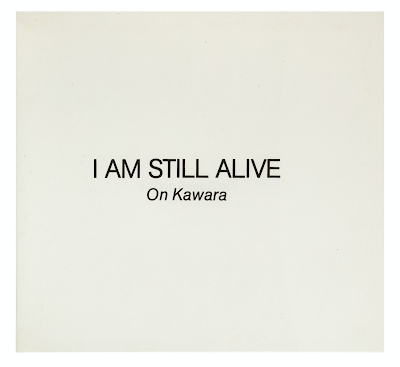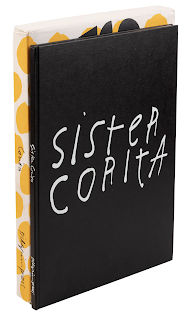Friday, December 31, 2021
Wednesday, December 29, 2021
Vini Reilly | Calm
Vini Reilly
Calm
Berlin, Germany: 5b, 2018
36 ppl, 17.8 × 11 cm., staple-bound
Edition size unknown
Calm (or Guitar Solo in E Major) is a conversation between the Durutti Column musician Vini Reilly and journalist Dave Haslam.
Vini Reilly is an English musician who, since 1978, has been performing, recording and producing music as The Durutti Column. He was the first signing to Tony Wilson's influential Manchester label Factory Records. Morrissey tapped him to replace Johnny Marr on his solo debut Viva Hate. Brian Eno lists Reilly's album LC as his all-time favourite album and The Red Hot Chili Peppers' John Frusciante cites Reilly as "the best guitarist in the world".
In Calm, Reilly speaks with Manchester-based DJ and writer Dave Haslam about his relationship with music and his introduction to playing, his family life and early career, life beyond the music industry, death and his struggles with depression. The candid interview was recorded at Manchester Town Hall in 2013.
The fanzine is available from the publisher, here, for €6. They offer to donate the proceeds to the Campaign Against Living Miserably.
Tuesday, December 28, 2021
Jan Dibbets | Art & Project Bulletin 87
Autumn Structures to Edgar Fernhout (1912-1974)
Amsterdam, The Netherlands: Art & Project, 1975
4 pp., 29.7 x 42 cm., folded
Edition of approximately 800 copies
The 87th issue of the influential artist periodical is the final of six issues that Dibbets produced (after #9, #15, #36, #46 and #56). #87 follows Hamish Fulton and precedes Sol Lewitt.
The work consists of two full bleed photographs of leaves stitched together at the fold to suggest a single image.
Available at Division Leap, here, for $75.00 US.
Saturday, December 25, 2021
Merry Christmas from Chris Burden
"When you consider the range and number of these social transformations, it seems only natural that yet another persona would take its place on Burden’s list of selves—that of a plutocrat spreading the wealth. This is the form taken by Merry Christmas from Chris Burden, 1976, which traded anonymity for an assertive personhood and made an erstwhile misanthrope into a budding Maecenas. The transformation happened when the artist simply tucked a bank-crisp ten-dollar bill into each of one hundred envelopes printed specially for the occasion, complete with his return address. A separate insert offered Christmas greetings to the hundred artist-recipients of Burden’s largesse. Thirty-five years ago, was this a big gesture or a small one? The answer, like so much in economic relations, depends on where you stand, your place in the economic landscape and how it shapes your point of view. And it also depends on the perceptions of those around you. Like the proverbial tree falling in the forest, money talks only when someone hears what it says. It is easy to imagine Burden’s offering being quite carefully parsed by its beneficiaries, though whether gratefully or skeptically is harder to decide."
- Anne M. Wagner, Artforum, 2011
"The season's cheeriest Christmas card was undoubtedly that sent by Chris Burden, the West Coast conceptualperformance artist, to 100 selected art worldlings, ranging from Vito Acconci to Diana Slotnick. Its dignified message, in script print on an elegant white folded card, read “Merry Christmas from Chris Burden.” Inside was a crisp new $10 bill.
“Of course it's an art piece,” said Mr. Burden from his home in Venice, Calif. “It's just a funny way of treating money, like a joke on the old Christmas thing where your grandmother sends you cash. To me, the money was simply raw material, like wood, metal or anything else an artist uses.”
Mr. Burden says he sent half of the $10's to friends and half to people he'd done business with. “I took note of the serial numbers,” he said, “and I'll include it in my list of pieces.” This one is relatively sedate. Mr. Burden's other “art pieces” include having a friend shoot him in the ann with a 22 rifle, staying in a locker for five days and firing match rockets at his wife.
The artist says the greenback idea has not produced a lot of feedback, although “some people did some funny things. About four or five sent the money back—they were mostly businesspeople with guilt about accepting it. One artist, Ilene Segalove, made it into a bowtie and returned it. Some people I sent it to owed me money or had given me a rough time in business dealings; they seemed to think it was a put‐down. On the other hand, a few just went out and spent it right away.”"
- The New York Times, 1976
Thursday, December 23, 2021
On Kawara | I am Still Alive
On Kawara
I Am Still Alive
Berlin, Germany: Edition René Block, 1975
[208] pp., 21 x 24 cm., slipcase
Edition of 450 numbered copies
In 1969, On Kawara sent a telegram that read "I AM NOT GOING TO COMMIT SUICIDE DON’T WORRY", followed by "I AM NOT GOING TO COMMIT SUICIDE WORRY" and " I AM GOING TO SLEEP FORGET IT".
These were followed, a month or so later, with another that read "I AM STILL ALIVE." Almost nine-hundred more identical telegrams would follow, addressed to dozens of friends and acquaintances, for more than three decades. By this time Kawara had stopped writing about or explaining his work. In response to inquiries from journalists or curators, he would typically send a telegram reading "I AM STILL ALIVE".
This first edition by Edition René Block (another would follow in 1978) contains reproductions of the telegrams at their original size and arranged chronologically. They were sent from December 1969 until 31 December 1977. Recipients include curator Germano Celant, artist Ken Friedman, New York gallerist Paula Cooper, Dutch gallerist Adriaan van Ravesteijn, collectors Herb and Dorothy Vogel, and many, many others.
On Kawara was born in Kariya, Japan, on this day in 1932.
Wednesday, December 22, 2021
Sister Corita
Corita Kent (Sister Mary Corita)
Sister Corita
Philadelphia, USA: Pilgrim Press, 1968
36 × 25 cm.
Edition size unknown
"Sister Mary Corita Kent was a Sister of the Immaculate Heart for over 30 years; she was an innovative artist, teacher, and advocate for social justice. A champion of "festive involvement" and "joyful creativity", Sister Corita favored serigraphy and watercolors to create beautiful works of political, cultural, and religious pop art advocating love, peace and confronting injustice.
In 1968 The Pilgrim Press published a Sister Corita box set, complete with over 30 prints of her art and a hardcover book on Sister Corita's life and her work.
According to Sister Corita, to be active in this world and to enrich society, one must be connected to the arts. "Part of being in the world is to understand the language people are using and the experiments they are engaged in so that we from another way of life may see the same problems and be able to cooperate in the ongoing work. Part of understanding the language and experiments comes from knowing about art and artists."
Sister Corita remained active in her artwork and active in social justice and advocacy until her death in 1986. Her art has been displayed in hundreds of galleries around the world and her legacy continues to live on."
- Pilgrim Press, 2019
Tuesday, December 21, 2021
Artists’ Invitations 1965-1985
[Bruno Tonini, ed.]
Artists’ Invitations 1965-1985
Ravenna, Italy: Danilo Montanari Editore, 2019
510 pp., 16.5 x 24 cm., softcover
Edition size unknown
Many artists would presumably have no interest in creating a postcard to advertise their exhibition, happy to allow the gallery staff to design, print and distribute, preferring producing the work over its promotion. Others (myself included) relish the opportunity to use the format of the invitation as venue for a new work, or different context. Or just as an opportunity to play around with materials.
Putting an image of the most impressive piece in the show is likely a good method to ensure that it sells, but I would rather use the space of the card to expand upon the show, even if only slightly.
The category of 'artists' ephemera' has become a sub-genre of artists' publications in the last thirty or so years. My own collection is negligible, though I've curated a couple of exhibitions of ephemera (and their distant cousin, the performance relic) for YYZ in Toronto and MST in Calgary. I also contributed an essay on the subject of ephemera to the Open Studio publication Printopolis.
I always attribute the increased interest in ephemera both to pioneering art dealers, like Harry Ruhe and Steven Leiber (whose book Extra Art: A Survey of Artists' Ephemera 1960-1999 paved the way for titles like this, and the MoMA catalogue Please Come to My Show) and to a collector's desire to own a work that was possibly designed to thwart such ownership. I'm thinking of certain works in the genres of Conceptual Art, Land Art, Performance Art, etc. etc. If you can't buy Robert Barry's Closed Gallery, the next best thing is to acquire the announcement card, I guess.
For me, collecting this material is of interest because you can amass a decent collection for free. Even if I'm not particularly interested in a particular example, I tend to save invitations when I have a clear sense that they were designed by the artist.
When I was at Art Metropole we would always take a binder of ephemera to the Basel Art Fair, primarily for collector Christoph Schifferli to peruse and shop from. These items ranged from recent mailings to duplicate materials from Art Metropole's archive. The works in Artists’ Invitations 1965-1985 come from his impressive collection, and the collection of editor Bruno Tonini and his wife Alessandra.
Tonini's title aims to illustrate this lesser known aspect of the ’60s, ‘70s, and ’80s art world, with a particular focus on Minimalism, Conceptual Art, Land Art, Pop Art, Fluxus, and Actionism, including Spanish and South American art.
Sunday, December 19, 2021
Vito Acconci | Making Public
Vito Acconci
Making Public
The Hague, The Netherlands: Stroom, The Hague's Center for Visual Arts, 1993
138 pp., 20 x 16 cm., spiral bound
Edition size unknown
Subtitled "Models, projects for streets, squares and parks" this title was published in conjunction with an exhibition by Acconci in the Stroom gallery space. Introduction by Lily van Ginneken and design by Irma Boom. In Dutch and English.
Subscribe to:
Posts (Atom)



















































